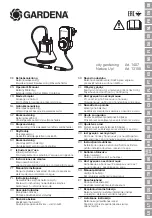
12. Connect the hose extending from the flowmeter connection labeled
“IN", to the other end of the adapter (Fig. 13).
13. Install the second FST connection adapter to the fuel line run-
ning to the fuel rail. If the fuel line connection used by the vehicle
manufacturer is a 3/8" quick-connect style (SAE J2044), a second
adapter is not required.
14. Connect the hose extending from the flowmeter connection labeled
“OUT", to the other end of the adapter or directly to the fuel line
running to the fuel rail, depending on the type of connection (Fig.
14).
15. Before proceeding:
Double check the connections. The tester should be installed such
that the fuel flowing from the tank to the engine enters the FST
through the port labeled “IN", out of the tester through the port
labeled “OUT", and on to the fuel rail.
Route and secure the clear pressure relief and bypass hoses into
an approved fuel container
Route the flowmeter inlet and outlet fuel hoses away from rotating
engine components, belts, fans, and hot exhaust components
Remove the fuel spillage rags
Reconnect components such as PCV tubes, wiring harnesses,
vacuum tubes, etc., that were disconnected to gain access to the
fuel line connection.
Check the operating position of the flow control valve on the side of
the flowmeter. Ensure it is in the OPEN position pointing down (Fig.
15).
16. Re-enable the fuel pump (if previously disabled), and cycle the
ignition switch to the ON position for a brief time, and then back
OFF. Do not start the engine.
On most vehicles, cycling the ignition ON and OFF will allow the
fuel pump to run briefly, and prime the tester. After cycling the igni-
tion, check all fuel connections for leaks. If all fitting connections
are secure, the installation is complete and the FST Pro is ready to
be used for diagnostic tests.
Form 824262
Page Number - 11
Fig. 13
Fig. 15
Fig. 14












































